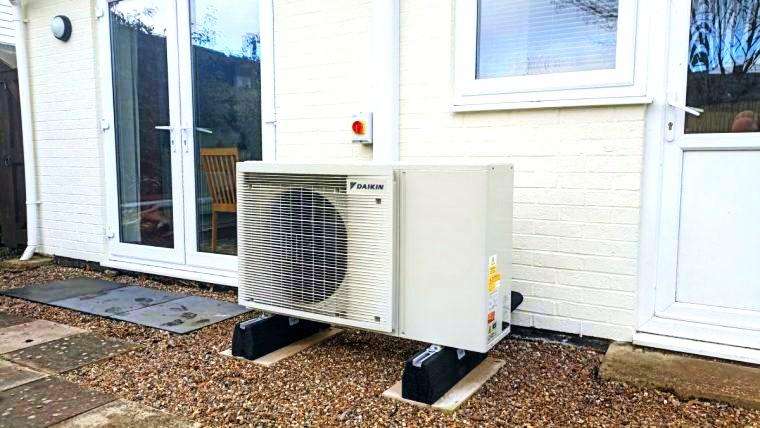In October, Paul Philpot, 54, installed an air source heat pump in his three-bedroom bungalow near Woodbridge, East Anglia, to reduce his electricity bills to just £1 per day during the peak of winter. Despite temperatures plummeting to well below freezing throughout January, Philpot's energy bills are now less than his previous heating system.“I priced up a new oil boiler, a plastic oil tank, and the radiators needed replacing as well, and with the Government grant, changing to a heat pump just looked very appealing,” he explained.
“I’ve found that as long as we are on a suitable heat pump tariff, the running costs are equal – if not less – than we used to spend on oil to heat our house.”Heat pump sales shot up by 63 per cent to nearly 100,000 last year, figures revealed on Wednesday showed, as customers look to keep their bills down in the long term.
Mr Philpot said the whole system and installation cost £14,500 – of which £7,500 was covered by the Government’s boiler upgrade scheme and a further £2,000 by a grant through his mortgage provider Halifax.He also purchased 19-kilowatt-hour batteries and an inverter, costing him a further £6,000, which charge up overnight during cheaper, off-peak times. This allows him to heat his home throughout the day without paying the most expensive rates with his provider Tomato Energy, a personalised tariff provider, giving him a discounted rate for doing so.
“In January we’re paying £1 a day – which is ridiculous,” Mr Philpot said. “It’s going to be £30 for the for the month.“Yes, I’ve had to pay for the batteries”, he said, “but the way I see it is rather than that a monthly charge going off to Edf, it’s going towards paying for the batteries. And then, after a few years. the batteries are mine, and they’ve paid for themselves, and off we go with this cheap heating.”
Mr Philpot said he was able to run the system “pretty much all the time but at a very low rate”, keeping the house between 19-20°C.
He explained that while traditional central heating would blast out heat for a period to heat the home before cooling down and then blasting again, he was able to maintain a low but lasting temperature.
The radiators are probably around 35-40°C, which to the touch they’re hardly on,” he said. “You can hardly feel them.”
Mr Philpot said the system sits outside his kitchen door and pumps into his old boiler cupboard where the water tank sits, which then flows into his radiators.
He said the initial decision was a “gamble, and still is a gamble,” fearing another gas crisis that may see his energy provider go broke.
“I hear a lot of negativity and I can see where that negativity comes from,” he said. But if you’re mindful, and you’re happy to get involved with a little bit of thinking like having batteries installed or getting the right tariff, I think [heat pumps] are amazing.”
Only around one per cent of homes in the UK are primarily heated by a heat pump, with the upfront cost of installation proving a barrier for many households looking to make their homes more energy-efficient.
As the Government drives to switch the UK’s heating networks away from fossil fuels and towards renewable energy in the coming years, other users have raised concerns about the running costs of heat pumps, including maintenance and insulation.Mr Philpot also raised concerns about the “installer network” which he said was not always consistent in providing the best service.
“There are very bad installers, and you get a bargain, and you might be tempted to go down the bargain route. But you know you’ll have no end of problems, and they won’t set you up very well and your bills will be expensive,” he warned.
Simon Kaylor, 45, who fitted a heat pump 11 years ago to provide heating to a chapel that he was renovating to become his home, also warned while he was pleased with his system, the biggest drawback was “many installers don’t know what they’re doing”.
How heat pumps could become cheaper than gas boilers, according to scientists
“It didn’t have a gas supply, so we were sort of limited into what our options were,” the professional saxophonist said, leading him to discover the possibility of a heat pump that would allow for underfloor heating.
“It’s been really good,” he said, “but it’s been not without its problems.” Mr Kaylor explained that his installer had been jailed for fraud after lying that he was certified to fit the heat pump, meaning the musician and his wife were unable to access the Government’s grant.
A decade later, Mr Kaylor said he was still concerned that, should the system need fixing or replacing, “hardly anyone knows how to install them properly, and hardly anyone knows how to set them up”.
He explained that experts had looked at his system and said the heat pump had been “installed as you would expect a plumber to install a central heating system”, rather than to be efficient.
“I think my annual spend on our heating and lighting – bear in mind we live in a big stone, open plan home, with no gas – is about £2,400 a year, so it’s £200 quid a month,” he said.
“I’m a big fan of the heat pump,” he continued. “What I’m not a fan of is the fact that there are so many installers who don’t know what they’re doing, and it’s really difficult to get someone out who knows what they’re doing when you do need them.
“Surely someone who knows about AI and heat pumps could just design something where you could integrate the two,” he said.








.svg)



_1.jpg)
_3.jpg)